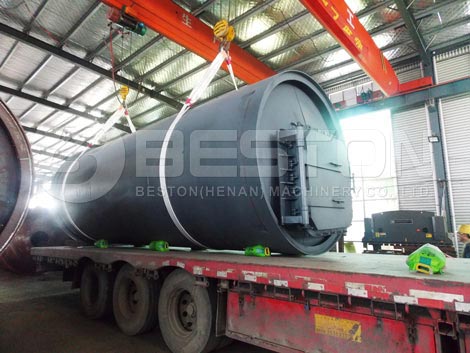A waste tire pyrolysis plant is both a lucrative and effective tire-waste management method. Every year, millions of waste tires are generated. In the past, most of this type of waste was either dumped, burned or dropped off in a landfill. This is why so many manufacturers have made the wise decision to invest in a tire pyrolysis plant.

What Is The Tire Pyrolysis Process?
Tires are mainly made up of rubber (which includes synthetic and natural rubber), carbon black, along with other inorganic and organic addition agents such as zinc oxide, sulfur, anti-ager, plasticizer, and more. The prosses of tire pyrolysis involved a sealed-furnace heated to a specific temperature. The primary chain of rubber in the tires breaks down into biopolymer, monomer, and fragments. These are then polymerized into different types of olefins, which removes volatile substances resulting in solid carbon. The primary end products from the process of pyrolysis include pyrolysis gas, steel wire, carbon black, and fuel oil.
The Features And Benefits Of A Continous Waste Tire Pyrolysis Plant
– Operates 24/7
The fully-continuous plants can run 24-hours a day. These plants employ an automatic discharging and feeding system. With this continuous system, you do not have to wait for the plant to cool down for the discharge process. You also get to save fuel and time to pre-heat the reactor. In addition to this, these automatic systems have made it efficient and easy to run saving you on labor input. Click here to know more: https://bestonpyrolysisplant.com/.
The reactor in continuous pyrolysis plants is horizontal rather than rotary. This design ensures that the temperature rises quickly. There is also a U-shaped tube which prolongs the overall pyrolysis-reaction time.
– Modular Design
Many of the continuous pyrolysis plants use a modular design. This makes these plants a lot more convenient to install and transport which decreases construction works. These designs also help you to save space.
Benefits Of The Small Tire Pyrolysis Plant
In comparison to the continuous pyrolysis plants, the small plants are a lot cheaper. This is one of the best options for smaller-scale investors. Today, investors can choose a plant according to their unique conditions, which includes the available space, their budget, and the raw materials they plan to use. Seek out reliable waste tyre pyrolysis plant manufacturer to purchase.

End Products Of A Waste Tire Pyrolysis Plant
In general, the tire pyrolysis plants produce combustible gas, steel wire, carbon black, and tire oil. All these products can generate profits indirectly and directly.
Auxiliary Equipment
To further improve and enhance the efficiency of pyrolysis, there are also pre-treatment products available. Some of these include tire shredders, oil-distillation machines, wire-drawing equipment, and dryers. For example, you will need shredding equipment if your raw materials exceed 20mm or a dryer when the water content in the raw materials exceeds 15%.
In general, operational temperatures for processing waste tires are around 200-450℃. The pyrolysis reactors adopt a heating process from the outside, and the furnace features a sealed design, this ensures that no gas leaks out increasing the efficiency of pyrolysis eliminating the risks of pollution and safety risks. More information on the blog: https://bestoncompany.blogspot.com/.